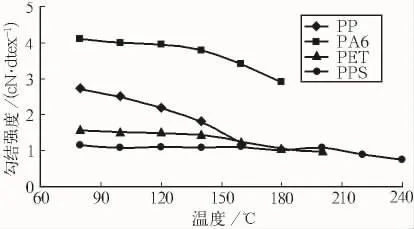大直径滤用聚合物单丝的热处理
马海燕 刘兆峰 张 军 马海军 (.东华大学纤维材料改性国家重点实验室,上海,0005; .南通大学化学化工学院,南通,6000)
大直径滤用聚合物单丝的热处理
马海燕1,2刘兆峰1张 军2马海军2(1.东华大学纤维材料改性国家重点实验室,上海,200051; 2.南通大学化学化工学院,南通,226000)
将大直径聚丙烯(PP)、聚己内酰胺(PA6)、聚对苯二甲酸乙二醇酯(PET)、聚苯硫醚(PPS)单丝进行热处理,测试纤维的拉伸强度及勾结强度。数据表明:PP纤维的强损温度为120~130℃,PA6纤维的强损温度在150℃左右,PET纤维的强损温度为160~170℃,而PPS纤维的强损温度为220~230℃。因此PPS单丝的热稳定性优于其他几种聚合物单丝。
单丝,热处理,结构,强度
高效机织过滤织物的原料通常采用直径为0.10 ~0.50 mm 的聚酰胺(PA6)、聚酯(PET)、聚烯烃(PP)单丝,但这些聚合物单丝不能满足强酸、强碱及180℃以上温度条件下可长期使用的要求[1-6]。聚苯硫醚(PPS)是一种半结晶聚合物,以苯环在对位上联接硫原子而形成刚性主链,结构上由于大π键的存在,所以性能极其稳定。PPS纤维在95℃下,浸泡在各种酸、碱、有机溶剂及氧化剂中一周,测出的纤维强度保持率基本为100%,可见PPS纤维具有优良的耐化学性。PPS纤维的热稳定性优良,它具有出色的耐高温性,熔点达285℃,高于目前工业化生产的其他熔纺纤维[7-9]。本文通过对大直径聚丙烯(PP)、聚己内酰胺(PA6)、聚对苯二甲酸乙二醇酯(PET)、PPS单丝的热处理,测试单丝的结构及力学性能变化。
1 实验部分
1.1 实验原料
PP 单丝:0.12、0.25 mm;
PA6 单丝:0.12、0.20 mm;
PET 单丝:0.12、0.18 mm;
PPS 单丝:0.20、0.45 mm。
1.2 实验仪器
差示扫描量热仪:200 F3型,德国耐驰仪器制造有限公司,温度范围为室温~400℃,升温速率为10℃/min,参比物为石英砂,测试气氛为氮气保护,氮气流量为20 mL/min。
扫描电子显微镜:S-550型,日本日立公司,将初生纤维置于液氮中,在超低温冷却状态下折断制得横向断口。在纤维表面镀上一层金属膜后,通过扫描电镜观察其截面和表面的形态。
电子强力仪:GY061型,莱州市仪器有限公司,量程为130 N,拉伸速度为100 cm/min,试样定长为250 mm。
2 结果与讨论
2.1 大直径聚合物单丝的热分析
对大直径 PP、PA6、PET、PPS单丝进行热分析,结果见图1和表1。
由图1和表1可以看出,PPS的熔点最高,达到280℃左右。这主要是由于PPS是一种半结晶聚合物,它以苯环在对位上联接硫原子而形成刚性主链,同时结构上有大π键的存在。

图1 不同聚合物单丝的DSC图

表1 PPS、PET、PP、PA6 单丝的热分析数据
2.2 热处理温度对单丝强度的影响
图2和图3分别为热处理时间为60 min时,各种单丝的断裂强度及勾结强度与温度的关系。

图2 热处理时间为60 min时断裂强度与温度的关系

图3 热处理时间为60 min时勾结强度与温度的关系
由图2及图3可知,当纤维热处理时间一定时,随着温度的升高,PP单丝的断裂强度损失最大,PPS的断裂强度损失最小,说明PPS纤维具有良好的热稳定性[10]。当温度低于220℃时,PPS纤维的断裂强度几乎不受温度影响,这主要与PPS自身的结构密切相关[11]。PPS分子链是由苯环经对位硫原子交替连接构成的,分子结构中含有刚性、耐热性好的亚苯基及柔性、耐热性好的硫醚键,且苯环的刚性结构由柔性的硫醚键连接起来,故PPS纤维比常规纤维具有更优良的耐热性和热稳定性[12-14]。
2.3 热处理时间对单丝强度的影响
图4为热处理温度分别为150、180、210和230℃时,各种单丝的断裂强度与时间的关系。
由图4可以看出,在同一温度下,随着热处理时间的延长,四种纤维的断裂强度都有所下降,其中PP纤维的强度下降最为明显,其次是PA6、PET纤维。PPS在230℃下热处理时,随着热处理时间的增加,强度损失仍不明显,可见PPS具有优良的耐热性能,能在较高的温度下长期使用。
在热处理过程中,温度的高低极为重要。当温度接近各种纤维的软化点时,分子链的运动过分剧烈,不仅消除了纤维上的内应力,同时使纤维结构产生较大变化,会出现解取向,结晶度也发生变化,从而导致纤维的强度大幅度下降。
2.4 热处理对聚合物单丝结构的影响
图5为各种单丝经不同温度热处理后的SEM图。
由图5可以看出,随着热处理温度的提高,各聚合物单丝的结构出现了不同程度的疏松,而PPS纤维在230℃的热处理温度下仍能保持其原有的结构,不出现疏松。
3 结论
(1)PP纤维的强损温度为120~130℃,PA6纤维的强损温度在150℃左右,PET纤维的强损温度为160~170℃,而PPS纤维的强损温度为220~230℃,表明PPS纤维具有优良的耐热性能。
(2)随着热处理温度的提高,各聚合物单丝的结构均出现了不同程度的疏松,而PPS纤维在230℃下仍能保持其原有的形态结构。

图4 不同热处理温度时纤维断裂强度与时间的关系

图5 不同热处理温度处理后纤维的SEM图
[1]GIL A,MEDRANO M,MARTORELL I,et al.State of the art on high temperature thermal energy storage for power generation materials and modellization[J].Renewable and Sustainable Energy Reviews,2010,14(1):31-35.
[2]YANG Ying,BEWLAY B P,CHEN Shuanglin,et al.Application of phase diagram calculations to development of new ultra-high temperature structural materials[J].Transactions of Nonferrous Metals Society of China,2007,17(6):1396-1404.
[3]GAWIN D,PESAVENTO F,SCHREFLER B A.Modelling of hygro-thermal behaviour of concrete at high temperature with thermo-chemical and mechanical material degradation[J].Computer Methods in Applied Mechanics and Engineering,2003,192(13/14):1731-1771.
[4]SEGUCHI T,YAGT I,ISHIKAWA S,et al.New material synthesis by radiation processing at high temperature-polymer modification with improved irradiation technology[J].Radiation Physics and Chemistry,2002,63(1):35-40.
[5]AHCI E,TALREJA R.Characterization of viscoelasticity and damage in high temperature polymer matrix composites[J].Composites Science and Technology,2006,66(14):2506-2519.
[6]TANTHAPANICHAKOON Winyu,HATA Mitsuhiko,NITTA Kohhei,et al.Mechanical degradation of filter polymer materials:polyphenylene sulfide[J].Polymer Degradation and Stability,2006,91(11):2614-2621.
[7]LANGER Luc,BILLAUD Denis,ISSI Jeanpaul.Thermal conductivity of stretched and annealed poly(pphenylene sulfide)films[J].Solid State Communications,2003,126(6):353-357.
[8]TANTHAPANICHAKOON Winyu,FURUUCHI Masami,NITTA Kohhei,et al.Degradation of semi-crystalline PPS bag-filter materials by NO and O2at high temperature[J].Polymer Degradation and Stability,2006,91(8):1637-1644.
[9]MAHIEUX C A,SCHEURER C.Elevated temperature bending stress rupture behavior AS4/APC-2 and comparison with AS4/PPS literature data[J].Composites Part A:Applied Science and Manufacturing,2002,33(7):935-938.
[10]SINMAZCELIK Tamer.Natural weathering effects on the mechanical and surface properties of polyphenylene sulphide(PPS)composites[J].Materials & Design,2006,27(4):270-277.
[11]SINMAZCELIK Tamer,TASKIRAN Isa.Erosive wear behaviour of polyphenylene sulphide(PPS)composites[J].Materials & Design,2007,28(9):2471-2477.
[12]VIEILLE Benoit,AUCHER Jeremie,TALEB Lakhdar.Influence of temperature on the behavior of carbon fiber fabrics reinforced PPS laminates[J].Materials Science and Engineering:A,2009,517(1/2):51-60.
[13]崔小明.聚苯硫醚的生产及应用[J].工程塑料应用,2003,31(12):60-64.
[14]周其凤,范星河,谢晓峰.耐高温聚合物及其复合材料[M].北京:化学工业出版社,2004:100.
The heat treatment of the large diameter filter monofilaments
Ma Haiyan1,2,Liu Zhaofeng1,Zhang Jun2,Ma Haijun2
(1.State Key Laboratory of Fibers Modification,Donghua University;2.College of Chemistry and Chemical Engineering,Nantong University)
The tensile strength and loop strength of the large diameter monofilaments of PP,PA6,PET,PPS were tested respectively after the heat treatment.The results showed that the temperature of strength loss of PP monofilaments was 120~130℃,the temperature of strength loss of PA6 monofilaments was about 150℃,the temperature of strength loss of PET monofilaments was 160~170℃ and the temperature of strength loss of PPS monofilaments was 220~230℃.The heat resistance of the PPS monofilaments was superior to that of other monofilaments.
monofilament,heat treatment,structure,strength
TQ342.62
A
1004-7093(2011)04-0032-04
2010-08-19;修改稿:2011-03-11
马海燕,男,1964年生,高级工程师。主要从事合成纤维成形研究。

